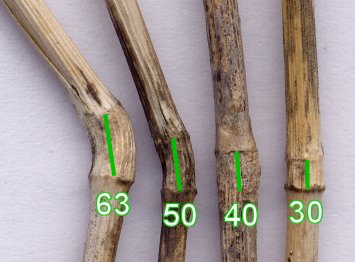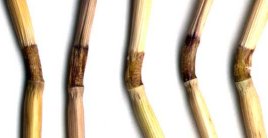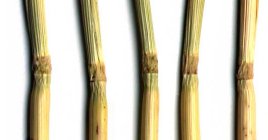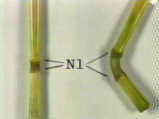W.C. Levengood and Marilyn J. Ruben wrote in 2003 that there were fourteen unusual features in crop circles [1]. The first feature is given as:
"1) Significantly elongated or expanded, apical nodes (pulvini) on plant stems."
In an article published on the Internet in 2002, by Eltjo Haselhoff, PhD, a commonplace cause of node expansion is indicated as:
"The stems of corn-type plants are characterized by little 'knuckles', at several positions along the stems (see Figure 1). These nodes act as a kind of ligament. They allow the plants to bend towards the light, even after they have grown to their full length."
He adds:
"Although there are known biological effects which can create this extension of the nodes, these known effects were easily eliminated."
But he says nothing on the reasons of this easy elimination neither which of these known biological effects are eliminated nor if they are all eliminated.
He also adds:
"The effect of extension of the nodes can be caused by the action of the heat, probably caused by microwave radiation."
This sentence was almost systematically interpreted as meaning that it is a proven fact that microwaves cause the crop circles. It is not what it means.
Outside a crop circle, plants grow undisturbed. Within the crop circles, plants have been flattened. In this situation, plants start to recover and try to stand vertical again, which gives the commonplace explanation of the nodes expansion feature of crop circles rigid stems plants. Node expansion is how rigid stem plants re-orient their stems to the sun after flattening.
W.C. Levengood's strangeness feature 1 for crop circle is therefore not strange. It signals for no mystery, since any flattening of the crop, whether by pranksters, aliens, balls of lights, paranormal forces etc., would result in the same node expansion. Hence the proof that crop circles are not made by prankster must be found elsewhere.
The picture below shows four stems of rigid-stem grass from my own garden and illustrates a point everyone can verify for his/her own enlightment: the more the stem must bend to reach the sun, the more the node expands.

|
(The stems on my photograph are ordinary stems that were not within a crop circle).
Reactions to the above:
Before publication I submitted this article for comment to a French Internet ufology discussion group. Three responses were given, that are unfortunately unusable to me. No positive feedback was given, the reactions were:
In the first part of this article, I show that the nodes of the plants with rigid stems are longer when a plant was laid down and tries to stand up again than the length they have when the plant was not disturbed. The mechanism is known and described by Dr. Haselhoff:
"The stems of corn-type plants are characterized by little 'knuckles', at several positions along the stems (see Figure 1). These nodes act as a kind of ligament. They allow the plants to bend towards the light, even after they have grown to their full length."
In result, I must expect that samples of plants with rigid stem taken in the crop circles and compared with control samples taken outside of the same crop circles also shows that the plants taken in the crop circles tried to stand up and thus have nodes longer than those undisturbed outside of the crop circles.
All that is left to do is to check the hypothesis, for that purpose I explored images of such compared samples shown on the Internet to validate or invalidate this point. By examining such images which are presented by proponents of an exotic cause of the crop circles, I also make sure that I cannot be charged of using biased data. What follows is what I found.
|
The photograph on the top shows plants taken in the crop circle, and that of the bottom shows plants taken out of the crop circle, the author presenting these photographs as evidence of the strangeness of the lengthening of the nodes in a crop circle case at Edmonton in 1999. |


|
I do see that the plants which tried to stand up and have angled stems at the nodes, do have nodes longer than the plants which were not disturbed and are still straight.
Source: http://www.cropcirclequest.com/edmonton99/edmontonnodes.html
The plants in the crop circle tried to stand straight again, this is why their nodes expanded.
|
In this other example, two plants are shown, that on left is taken outside of a crop circle, the one on the right is taken inside the same crop circle, the author presenting the photograph as "non-falsifiable proof" of the strangeness of the crop circles. |

|
Source: http://www.greatdreams.com/anover.htm
I do see that the plant which tried to stand up has a longer node than the plant which is straight.
Correctly documented images of that are rather rare. Very often, the stems coming from the crop circle are shown without control stems being shown. Almost always, nothing indicates that the shown stems would not be samples chosen precisely for what they show, nothing indicates that sampling was done either at random or complete as it should be. I found however in these images the clear demonstration of what I suggested, which is nothing other than the say of Dr. Haselhoff defending the thesis that the crop circles are produced by "balls of lights":
"The stems of corn-type plants are characterized by little 'knuckles', at several positions along the stems (see Figure 1). These nodes act as a kind of ligament. They allow the plants to bend towards the light, even after they have grown to their full length."
And thus, W.C. Levengood's point 1...
"1) apical nodes (pulvini) significantly prolonged or inflated, on the stems of the plants."
... is not valid.
And consequently, the proof that the crop circles are not all made by very human land-artists or pranksters must be found elsewhere.